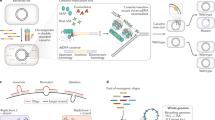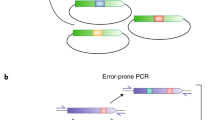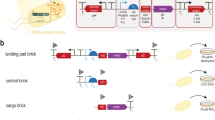Abstract
We describe a highly engineered in vivo cloning method, mating-assisted genetically integrated cloning (MAGIC), that facilitates the rapid construction of recombinant DNA molecules. MAGIC uses bacterial mating, in vivo site-specific endonuclease cleavage and homologous recombination to catalyze the transfer of a DNA fragment between a donor vector in one bacterial strain and a recipient plasmid in a separate bacterial strain. Recombination events are genetically selected and result in placement of the gene of interest under the control of new regulatory elements with high efficiency. MAGIC eliminates the need for restriction enzymes, DNA ligases, preparation of DNA and all in vitro manipulations required for subcloning and allows the rapid construction of multiple constructs with minimal effort. We show that MAGIC can generate constructs for expression in multiple organisms. As this new method requires only the simple mixing of bacterial strains, it represents a substantial advance in high-throughput recombinant DNA production that will save time, effort and expense in functional genomics studies.
This is a preview of subscription content, access via your institution
Access options
Subscribe to this journal
Receive 12 print issues and online access
$209.00 per year
only $17.42 per issue
Buy this article
- Purchase on Springer Link
- Instant access to full article PDF
Prices may be subject to local taxes which are calculated during checkout







Similar content being viewed by others
References
Smith, H.O. & Wilcox, K.W. A restriction enzyme from Hemophilus influenzae. I. Purification and general properties. J. Mol. Biol. 51, 379–391 (1970).
Danna, K. & Nathans, D. Specific cleavage of simian virus 40 DNA by restriction endonuclease of Hemophilus influenzae. Proc. Natl. Acad. Sci. USA 68, 2913–2917 (1971).
Cohen, S.N., Chang, A.C., Boyer, H.W. & Helling, R.B. Construction of biologically functional bacterial plasmids in vitro. Proc. Natl. Acad. Sci. USA 70, 3240–3244 (1973).
Backman, K. & Ptashne, M. Maximizing gene expression on a plasmid using recombination in vitro. Cell 13, 65–71 (1978).
Uetz, P. et al. A comprehensive analysis of protein-protein interactions in Saccharomyces cerevisiae. Nature 403, 623–627 (2000).
Li, S. et al. A map of the interactome network of the metazoan. C. elegans. Science 303, 540–543 (2004).
Ho, Y. et al. Systematic identification of protein complexes in Saccharomyces cerevisiae by mass spectrometry. Nature 415, 180–183 (2002).
Gavin, A.C. et al. Functional organization of the yeast proteome by systematic analysis of protein complexes. Nature 415, 141–147 (2002).
Liu, Q., Li, M.Z., Liebham, D., Cortez, D. & Elledge, S.J. The univector plasmid fusion system, a method for rapid construction of recombinant DNA without restriction enzymes. Curr. Biol. 8, 1300–1309 (1998).
Hartley, J.L., Temple, G.F. & Brasch, M.A. DNA cloning using in vitro site-specific recombination. Genome Res. 10, 1788–1795 (2000).
Walhout, A.J. et al. GATEWAY recombinational cloning: application to the cloning of large numbers of open reading frames or ORFeomes. Methods Enzymol. 328, 575–592 (2000).
Bethke, B. & Sauer, B. Segmental genomic replacement by Cre-mediated recombination: Genotoxic stress activation of the p53 promoter in single-copy transformants. Nucleic Acids Res. 25, 2828–2834 (1997).
Nebert, D.W., Dalton, T.P., Stuart, G.W. & Carvan, M.J. Gene-swap knock-in cassette in mice to study allelic differences in human genes. Ann. NY Acad. Sci. 919, 148–170 (2000).
Siegel, R.W. et al. Recombinatorial cloning using heterologous lox sites. Genome Res. 14, 1119–1129 (2004).
Frost, L.S., Ippen-Ihler, K. & Skurray, R.A. Analysis of the sequence and gene products of the transfer region of the F sex factor. Microbiol. Rev. 58, 162–210 (1994).
Metcalf, W.W., Jiang, W. & Wanner, B.L. Use of the rep technique for allele replacement to construct new Escherichia coli hosts for maintenance of R6K gamma origin plasmids at different copy numbers. Gene 138, 1–7 (1994).
Winans, S.C., Elledge, S.J., Mitchell, B.B., Marsh, L. & Walker, G.C. Site directed insertion and deletion mutagenesis with cloned fragments in Escherichia coli. J. Bacteriol. 161, 1219–1221 (1985).
Kaiser, K. & Murray, N.E. On the nature of sbcA mutations in E. coli K 12. Mol. Gen. Genet. 179, 555–563 (1980).
Yu, D. et al. An efficient recombination system for chromosome engineering in Escherichia coli. Proc. Natl. Acad. Sci. USA 97, 5978–5983 (2000).
Datsenko, K.A. & Wanner, B.L. One-step inactivation of chromosomal genes in Escherichia coli K-12 using PCR products. Proc. Natl. Acad. Sci. USA 97, 6640–6645 (2000).
Zhang, P., Li, M.Z. & Elledge, S.J. Towards genetic genome projects: genomic library screening and gene targeting vector construction in a single step. Nat. Genet. 30, 31–39 (2002).
Hashimoto, T. & Sekiguchi, M. Isolation of temperature-sensitive mutants of R plasmid by in vitro mutagenesis with hydroxylamine. J. Bacteriol. 127, 1561–1563 (1976).
Kuzminov, A. Recombinational repair of DNA damage in Escherichia coli and bacteriophage lambda. Microbiol. Mol. Biol. Rev. 63, 751–813 (1999).
Gumbiner-Russo, L.M., Lombardo, M., Ponder, R.G. & Rosenberg, S.M. The TGV transgenic vectors for single-copy gene expression from the Escherichia coli chromosome. Gene 273, 97–104 (2001).
Kast, P. pKSS–a second-generation general purpose cloning vector for efficient positive selection of recombinant clones. Gene 138, 109–114 (1994).
Heyneker, H.L. et al. Synthetic lac operator DNA is functional in vivo. Nature 263, 748–752 (1976).
Marians, K.J. et al. Cloned synthetic operator DNA is functional in vivo. Nature 263, 744–748 (1976).
Haldimann, A., Daniels, L.L. & Wanner, B.L. Use of new methods for construction of tightly regulated arabinose and rhamnose promoter fusions in studies of the Escherichia coli phosphate regulon. J. Bacteriol. 180, 1277–1286 (1998).
Shine, J. & Dalgarno, L. Determinant of cistron specificity in bacterial ribosomes. Nature 254, 34–38 (1975).
Kozak, M. Circumstances and mechanisms of inhibition of translation by secondary structure in eucaryotic mRNAs. Mol. Cell. Biol. 9, 5134–5142 (1989).
Bai, C. et al. SKP1 connects cell cycle regulators to the ubiquitin proteolysis machinery through a novel motif, the F-box. Cell 86, 263–274 (1996).
Paddison, P.J. et al. A resource for large-scale RNAi based screens in mammals. Nature 428, 427–431 (2004).
Cherepanov, P.P. & Wackernagel, W. Gene disruption in Escherichia coli:TcR and KmR cassettes with the option of Flp-mediated excision of the antibiotic determinant. Gene 158, 9–14 (1995).
Acknowledgements
We thank B. Wanner for providing the ara and rha promoters, bacterial strains and advice concerning their use; S. Sandler and S. Lovett for discussions; J.W. Harper and M. Schlabach for comments on the manuscript; A. Liang, R. McDonald and T. Westbrook for help with the transfections; and J. Liao for help in recipient vector construction. This work was supported by a grant from the US National Institutes of Health. S.J.E. is an Investigator with the Howard Hughes Medical Institute.
Author information
Authors and Affiliations
Corresponding author
Ethics declarations
Competing interests
The authors declare no competing financial interests.
Supplementary information
Supplementary Fig. 1
96-well mating. (PDF 78 kb)
Supplementary Table 1
Bacterial strains. (PDF 150 kb)
Supplementary Table 2
Primer sequences used in this study. (PDF 104 kb)
Supplementary Table 3
Plasmids. (PDF 51 kb)
Rights and permissions
About this article
Cite this article
Li, M., Elledge, S. MAGIC, an in vivo genetic method for the rapid construction of recombinant DNA molecules. Nat Genet 37, 311–319 (2005). https://doi.org/10.1038/ng1505
Received:
Accepted:
Published:
Issue Date:
DOI: https://doi.org/10.1038/ng1505
This article is cited by
-
Evidence that conserved essential genes are enriched for pro-longevity factors
GeroScience (2022)
-
MISSA 2.0: an updated synthetic biology toolbox for assembly of orthogonal CRISPR/Cas systems
Scientific Reports (2017)
-
Characterization of Inducible ccdB Gene as a Counterselectable Marker in Escherichia coli Recombineering
Current Microbiology (2017)
-
A strategy for enhanced circular DNA construction efficiency based on DNA cyclization after microbial transformation
Microbial Cell Factories (2015)
-
Efficient strategy for constructing duck enteritis virus-based live attenuated vaccine against homologous and heterologous H5N1 avian influenza virus and duck enteritis virus infection
Veterinary Research (2015)



